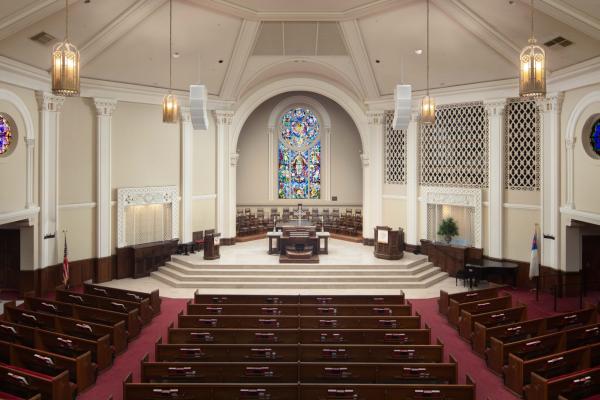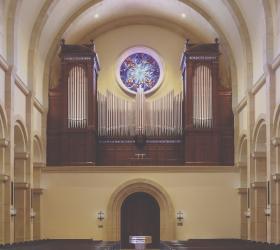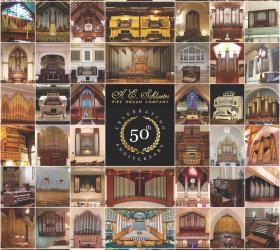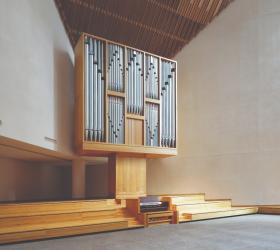
Lexington sits at the heart of the Bluegrass country of Kentucky. It has many claims to fame. It is the “Horse Capital of the World,” hands down, with hundreds of horse farms throughout the region. It is adjacent to Bourbon County, Kentucky, and home to fourteen bourbon distilleries. It is also home to what is arguably the “Mother Church” of the Christian Church (Disciples of Christ), namely Central Christian Church.
Central Christian Church is a founding congregation of the Christian Church (Disciples of Christ). Its roots go back to the Cane Ridge Revival of 1804. This event took place at the Cane Ridge Meeting House, near Paris, Kentucky, which was constructed in 1791 and is still in existence. Cane Ridge revivals were legendary, at times drawing as many as 20,000 Christians from Kentucky, Western Virginia, and southern Ohio for a week of socializing, lectures, and worship. The meeting house, constructed of ash logs and measuring fifty feet by thirty feet, is believed to be the largest single-room log structure in North America. It was at one of these revivals that the Reverend Barton Stone and other men of the cloth made the decision to leave the Presbyterian Church and establish the Christian Church, a church based on the Bible alone, and not on the specific Protestant creeds or Calvinistic doctrines that were so prevalent at the time. Following this, Reverend Stone preached in the central Bluegrass region, eventually settling in Lexington in 1815 where he continued his ministry. In 1831, in conjunction with adherents of Alexander Campbell (Disciples of Christ out of West Virginia) and Lexington’s Mill Street Baptist Church, they purchased a former cotton factory, which became Hill Street Christian Church. Hill Street Christian Church grew and prospered, and in 1842 built Main Street Christian Church. Main Street Christian Church grew and prospered, and in 1894 completed the construction of Central Christian Church on the corner of Lexington’s East Short Street and Walnut Street, which remains its home to this day.
The history of organs at Central Christian Church began with a Hook & Hastings tracker instrument in 1894. This was replaced in 1915 by a tubular-pneumatic-action organ by M. P. Möller. After a worship space fire in 1933, the Möller was rebuilt by Henry Pilcher’s Sons of Louisville, Kentucky. This was followed by an organ by the Holtkamp Organ Company in 1960.
Pipe organ projects are often long affairs. Such was the case at Central Christian Church. Our first meetings with the organ committee were in 2009. This was followed by a period of discernment as the committee chose the builder of their new organ. During this time, they visited the 1970 Holtkamp organ at Knox Presbyterian Church in the Hyde Park neighborhood of Cincinnati. The organ at Knox Presbyterian originally had much in common with the 1960 Holtkamp at Central Christian Church. It was very colorful and had wonderful ensemble qualities, but lacked the fullness and warmth that is a signature of our work today. In 2005 the Knox Presbyterian organ was rebuilt and expanded by Holtkamp to give it this desired fullness and warmth. The visit to Knox Presbyterian demonstrated in real time the general concepts in the proposal put forward by Holtkamp for the 1960 Central Christian Church pipe organ. Based on this visit, Holtkamp was chosen as the builder of the new organ at Central Christian Church. Time passed. Money was raised. Covid happened. And in 2021 a contract was signed.
Our work on the Central Christian project began with taking field measurements of all stops in the organ, including diameter, mouth width, cut-up, and voicing details for flue pipes, and diameter, length, and type of shallot for reed pipes. The results of this research were used to inform us as to which existing stops were most appropriate for the contract specification that we were working from. This ultimately resulted in our using twenty-two stops from the existing organ in the new organ project. Of these twenty-two stops, all were revoiced and ten were rescaled.
At a later date, we visited Central Christian to focus on the acoustical characteristics of the worship space. The space is large, but not overly so. The volume is roughly 300,000 cubic feet, with a seating capacity of 650. The walls and ceiling are hard plaster but with many windows. The floor and pews are wood but with carpet tapers in the aisles and pew cushions. During this visit we took measurements of the room acoustics. Our findings showed the room acoustics to be very good in the middle and high frequencies, but lacking in low frequency response, particularly in the main floor worship space seating, where low frequency support is so important in leading the congregation in song. (Interestingly, the low-end response in the balcony is much better than the low-end response on the main floor seating.) With this information in hand, we drew up the scales of all stops in the organ, with the aim of creating a sound palette that is diverse in color, with excellent ensemble characteristics and a full and embracing cascade of sound.
In many organ projects, placement of divisions can be very straightforward. For example, if the organ is free standing in the front or rear of the room, the divisions can be stacked, one on top of the other, with the pedal split to the left and right. At Central Christian, this is not the case. Since the rebuilding of the worship space at Central Christian following a devastating fire in 1933, the organ chamber was placed on the right side of the nave, above the baptismal pool and behind an ornate, acoustically open plaster screen. While this is an excellent location to project the sound of the organ to the congregation, it is not so for the choir. Because of the organ chamber location, anthems for the choir were almost always accompanied on the piano. To remedy this in the new organ project, we borrowed some space from the choir vesting room, a room that was adjacent to the left side of the main organ chamber. This gave us ample space for the Swell division, which now speaks directly into the chancel area and to the choir. This change in the location of the Swell division allows the choir to perform anthems with organ accompaniments for the first time in decades.
During the planning of the Central Christian organ, we had a discussion specific to the console—whether it should be stop-tab or drawknob. The unanimous choice of all musicians on staff and the organ committee was the signature Holtkamp stop-tab console. This is because stop-tab consoles are more ergonomic in design than drawknob consoles. Playing in general is easier on stop-tab consoles because the keys, stop-tabs, and music all lie in the same plane directly in front of the organist. The architectural detailing of the console is drawn from our work in the 1940s. The width of the console is somewhat greater than our stop-tab consoles of the past so that it could comfortably accommodate the number of stop-tabs.
There are many factors that go into a successful organ project. Most important is strong congregational leadership and strong pastoral leadership. Both of these characteristics were in place at Central Christian Church from the beginning of the project to the end.
The result is a new pipe organ that is also a strong leader for the church and general community, which will provide spiritual restoration, renewal, and rejoicing to the many families and individuals who worship at Central Christian Church, now and for generations to come.
—F. Christian Holtkamp
Photo credit: Matt Peel
The organ dedication series began in September 2023 and continues on Sundays at 4 p.m.: March 10, Schuyler Robinson; April 14, David Enlow; May 19, Clif Cason; June 16, Erich Balling and Lisa Hall.
GREAT (Manual II)
16′ Violone 61 pipes
8′ Open Diapason 61 pipes
8′ Violone (ext 16′) 12 pipes
8′ Rohrbourdon 61 pipes
4′ Octave 61 pipes
4′ Spitzflute 61 pipes
2-2⁄3′ Nazard 61 pipes
2′ Superoctave 61 pipes
1-3⁄5′ Tierce 61 pipes
2′ Mixture III–IV 232 pipes
8′ Trumpet 61 pipes
Great 16
Great Unison Off
MIDI on Great
16′ Harmonic Tuba (TC)
8′ Harmonic Tuba (W.P. 10′′) 61 pipes
4′ Harmonic Tuba (ext 8′) 12 pipes
SWELL (Manual III, enclosed)
16′ Flauto Dolce 61 pipes
8′ Geigen Diapason 61 pipes
8′ Gamba 61 pipes
8′ Voix Celeste (F6) 56 pipes
8′ Hohlflute 61 pipes
8′ Flauto Dolce (ext 16′) 12 pipes
4′ Octave Geigen 61 pipes
4′ Harmonic Flute 61 pipes
2′ Flautino 61 pipes
2-2⁄3′ Plein Jeu IV 244 pipes
16′ Oboe (ext 8′) 12 pipes
8′ Trompette 61 pipes
8′ Oboe 61 pipes
Tremulant
Swell 16
Swell Unison Off
Swell 4
MIDI on Swell
16′ Bourdon Pedal
16′ Harmonic Tuba (TC) Great
16′ Posaune Pedal
16′ Oboe Swell
8′ Bourdon Pedal
8′ Harmonic Tuba Great
8′ Posaune Pedal
CHOIR (Manual I, enclosed)
8′ Concert Flute 61 pipes
8′ Stopped Flute 61 pipes
8′ Dulciana 61 pipes
8′ Unda Maris (TC) 49 pipes
4′ Waldflute 61 pipes
2′ Octave 61 pipes
1-1⁄3′ Larigot 61 pipes
8′ Bassoon 61 pipes
8′ Clarinet 61 pipes
Tremulant
Choir 16
Choir Unison Off
Choir 4
MIDI on Choir
16′ Harmonic Tuba (TC) Great
8′ Harmonic Tuba Great
4′ Harmonic Tuba Great
PEDAL
32′ Bourdon (1–12 electronic)
16′ Open Diapason 32 pipes
16′ Violone Great
16′ Bourdon 32 pipes
16′ Flauto Dolce Swell
8′ Octave 32 pipes
8′ Violone Great
8′ Bourdon (ext) 12 pipes
8′ Flauto Dolce Swell
4′ Choralbass (ext) 12 pipes
4′ Bourdon (ext) 12 pipes
2′ Principal (ext) 12 pipes
32′ Contra Posaune (1–12 electronic)
16′ Posaune 32 pipes
16′ Oboe Swell
8′ Trumpet (ext) 12 pipes
8′ Oboe Swell
4′ Clarion (ext) 12 pipes
MIDI on Pedal
8′ Harmonic Tuba Great
4′ Harmonic Tuba Great
INTER-DIVISIONAL COUPLERS
Great to Pedal 8′, w/reversible piston & toe stud
Swell to Pedal 8′, w/reversible piston & toe stud
Swell to Pedal 4′
Choir to Pedal 8′, w/reversible piston & toe stud
Choir to Pedal 4′
Swell to Great 16′
Swell to Great 8′, w/reversible piston & toe stud
Swell to Great 4′
Choir to Great 16′
Choir to Great 8′
Choir to Great 4′
Swell to Choir 16′
Swell to Choir 8′
Swell to Choir 4′
Choir to Swell 8′
COMBINATIONS
Generals 1-2-3-4-5-6-7-8-9-10
piston and toe stud
Pedal 1-2-3-4-5-6 toe stud
Great 1-2-3-4-5-6 piston
Swell 1-2-3-4-5-6 piston
Choir 1-2-3-4-5-6 piston
Set piston
General Cancel piston
Full Organ Reversible piston and toe stud
Next piston (3) and toe stud (1)
Previous piston (3) and toe stud (1)
Manual Transfer piston
Zimbelstern Reversible piston
CONSOLE DETAILS
New Signature Holtkamp stop-tab console on moveable dolly for portability
Existing keyboards restored
Manual natural keys – ivory
Manual sharp keys – ebony
Existing pedalboard renovated
Pedal natural keys – maple
Pedal sharp keys – ebony
Stop tabs – ivory plastic
Organ bench with adjusting crank mechanism
Music rack light
Pedalboard light
Swell Expression Pedal
Choir Expression Pedal
Crescendo Pedal
Full Organ indicator light
Crescendo indicator light
MECHANICAL/ELECTRICAL DETAILS
Electrical control system by SSOS with 100 levels of memory, internal Record/Playback, and MIDI capability
New 3 H.P. blower
New .5 H.P. booster blower
Zimbelstern
Swell expression motors: two 8-stage Peterson expression motors
Choir expression motor: one 16-stage Peterson expression motor
Three solid state rectifiers
Start/Stop switch located on console
Wind pressures:
Great 3.5′′
Swell 4′′
Choir 3.25′′
Pedal 4.5′′
35 stops, 42 ranks, 2,445 pipes




